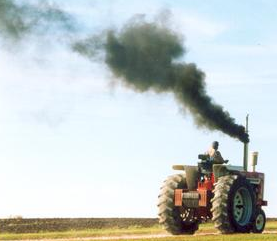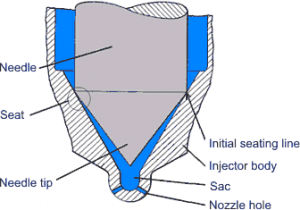
“Smoke on the water“
Whether or not you’re a fan of 1970s rock ballads, if you see Smoke on the Water, and it came out of your yacht’s exhaust, it may signal Trouble with a capital T. OK – that’s enough of that.
The exhaust gases coming out of a marine diesel engine should normally be crystal clear and the presence of smoke can indicate a problem, either in its early stages or possibly presenting a more immediate issue.
Thankfully, much like in the election of a new Pope, the colour of the smoke can give us some indication of what might be going on inside.
A word of caution though, the following smoke colour discussions imply a clear distinction between blue, black and white smoke. In fact, it can be difficult to study wispy grey smoke over the transom on a windy day and definitely say what colour it is. Additionally, cool evenings can cause condensation in the exhaust gases which is often fine. Nevertheless, if you can tell, the colour can provide some vital clues.

Black Smoke – partially burned fuel

Black smoke is the result of un-burned particles of carbon in the exhaust gases. Fuel has been ignited but hasn’t fully burned. This is usually due to either overloading of the engine or from poor fuel injection.
If the engine is overloaded, the governor adapts by increasing the amount of fuel being passed to the injectors. As the engine is overloaded, this means that there is more fuel than can be burned in the available oxygen resulting in incomplete combustion, and black smoke.
An overloaded engine can be caused by an over-sized propeller, or, more commonly, by a fouled propeller or hull. Driving your boat into a heavy sea or a strong headwind can, as you know, cause the hull to halt forward motion. This can also cause temporary periods of overloading of the engine. Overloading, incidentally, can cause its own issues other than incomplete combustion, such as overheating. Black smoke on a newly commissioned engine should immediately be reported to the installation team.
Another cause of black smoke is injectors with defective nozzles.

If the injector’s nozzle holes have become clogged by carbon deposits or the injector is worn in any other way, it can fail to atomise the fuel correctly. A malfunctioning injector can even dribble some fuel out after the main injection pulse. If the engine is correctly loaded, then the injectors should be your primary suspects in any case of black smoke. Injectors can be removed and tested by special facilities, but replacement can often be a more cost-effective solution, depending on your engine.
Other potential culprits for black smoke include the following causes of oxygen starvation to your engine;
- Dirty air filter
- Extremely warm air (which becomes less dense)
- Back pressure on the exhaust causing the turbo (if fitted) to slow down

Blue Smoke – oil being burned
Again – a word of warning about smoke colour claims. The “blue” coloured smoke comes from traces of engine oil that are being burned in the cylinder during combustion. That’s all to say – it’s not really that blue. A more reliable indicator of the following problems is that your engine is using up oil.
Blue smoke indicates the burning of engine oil. Oil can usually find its way into the combustion chamber either by slipping up past the piston rings or by by slipping down past the valves. This can mean that your engine is nearing its end-of-life but a possible solution is to de-carbonise.
Other causes worth checking before a top-end rebuild is to check the oil level. In rare cases, if too much oil is added to the crankcase, oil pressure can build up and oil can be forced past the piston rings into the combustion chambers.

White Smoke – water or unburned fuel
White smoke has two distinct and separate causes. One source is water vapour in the exhaust gases. The other is totally unburned but atomised fuel being blown directly out of the exhaust. Let’s deal with them separately.
Water Vapour
If you can, observe the white smoke on a warm still day; if the smoke dissipates quickly into the air then it is probably water vapour. Another way to tell is to put your hand into the smoke (being careful not to get burned) and determine if the liquid that now coats your hand is water or oil-based – first give it a good sniff and if it smells strongly of diesel then it probably is diesel. If you think that it’s not diesel, then it’s probably water or coolant depending on your engine. Anti-freeze is extremely harmful so don’t taste it if you have an indirect cooled engine.
If the white “smoke” is actually water vapour, then dirty fuel may well be the culprit. Bio-diesel has a particular tendency to absorb water.
Diesel School: Click to learn more about Bio-Diesel
If your fuel is good, then a leaking cylinder head gasket might be the cause or, even worse, a crack in the head or the cylinder allowing cooling liquid into the combustion chamber. If your engine has indirect cooling, you should keep an eye on the level of coolant as this being used up further indicates one of the “leaking” causes.
Unburned Fuel
White smoke from unburned fuel indicates a serious injector problem. This could be the fuel pump, the fuel lines or the injectors themselves. Next step might be to remove the injectors, get them tested or just replace them, depending on the cost of them.

